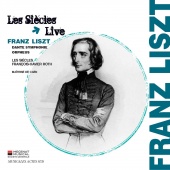Liszt: Dante-symphonie, Orpheus
Label: Actes Sud Catalog: ASM 07 Format: CD Les Siecles; Roth, Francois-XavierComposed by: LISZT, F.,La Maîtrise de Caen, Les Siècles, François-Xavier Roth In his Dante Symphonie, Liszt sought to evoke the three canticas of the Divine Comedy and lead us, as Virgil led Dante, from Hell to Paradise, via Purgatory. The first Inferno movement opens on a pounding brass theme, an expression of the terrifying exhortation engraved on the Gates of Hell: Abandon all hope, ye who enter here. The orchestra deploys spectacular effects to plung the listener into the fires of Hell and the torments of the damned. In the Pugatorio movement, depicting souls awaiting salvation, Liszt develops a series of vague and subtle harmonies which finally gather definition to lead us into the Magnificat - the ultimate Vision, that of Heaven - with its choirof angels bringing forth the radiance of theophany. It has been thought that Wagner convinced Liszt to not compose a Paradizo movement due to mortal limitations. This does not tell the full story. liszt did indeed compose a Paradizo, in accordance with the subtleties of the Divine Comedy and his own perfect knowledge of its theology. Liszt's orginal title for the Magnificat was Vision, , Liszt knew that at the end of the Purgatorio, Dante is invited to contemplate Heaven, and at this moment, time and space evaporate. Heaven is an immaterial province of ecstasy, perfectly expressed by an extraordinary score, formed of a fine and subtle transparent gossamer of murmuring instruments, a radiant rustling swathe of luminescent seraphims' wings, which accompanies the angel's canticle to the Virgin Mary.  Price: $19.98 Price: $19.98 |












